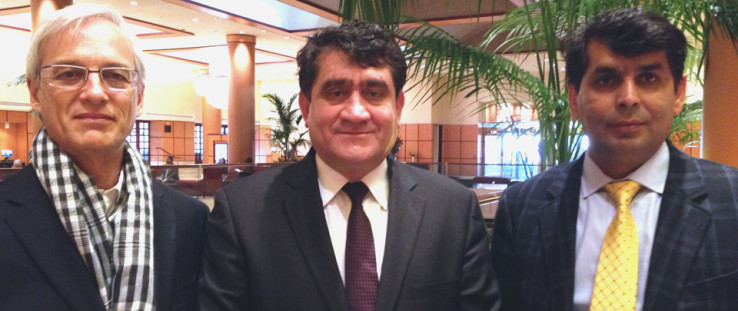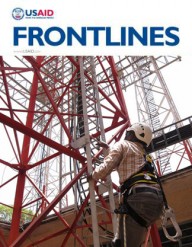 Left to right: Gene Lin, Abdul Razique Samadi and Mirwais Alami
Kristen Madler, USAID
Left to right: Gene Lin, Abdul Razique Samadi and Mirwais Alami
Kristen Madler, USAID
 Left to right: Gene Lin, Abdul Razique Samadi and Mirwais Alami
Kristen Madler, USAID
Left to right: Gene Lin, Abdul Razique Samadi and Mirwais Alami
Kristen Madler, USAID
USAID’s Kristen Madler recently interviewed energy officials visiting the United States from Afghanistan—Abdul Razique Samadi, chief executive officer of Da Afghanistan Breshna Sherkat (DABS), the Afghan utility company; Mirwais Alami, DABS chief commercial officer; and Gene Lin, program manager for USAID/Afghanistan’s Power Transmission Expansion and Connectivity Project (PTEC)—to get an update on the current energy situation.
But first a little background.
The energy network in Afghanistan is made up of nine isolated systems, which deliver electricity to only about a quarter of Afghan households, according to the World Bank. This percentage varies widely from zero in rural areas to as high as 90 in urban areas. Increasing Afghanistan’s energy supply and expanding the energy grid to underserved areas is a national priority. Without low-cost, reliable grid power, population centers either go without power or rely on limited amounts of high-cost and unsustainable diesel-generated power. Afghanistan’s current energy supply consists of 77 percent imported power, 21 percent hydro power and 2 percent diesel-generated power.
Many donors are contributing to Afghanistan’s energy sector, including USAID, the U.S. Department of Defense, the Asian Development Bank (ADB) and the World Bank. From 2002 to 2011, USAID provided close to $2 billion of energy sector assistance and has plans to spend at least $500 million over the next five years. The results of those efforts are starting to build.
For example, prior to 2009, a limited number of households in Kabul were receiving power for about four hours every other day with frequent outages. In 2009, ADB completed a 220-kilovolt transmission line that initially delivered 125 megawatts of power from Uzbekistan. Although this did not meet Kabul’s full electricity demands, it did usher in a wave of strong economic growth. That received a boost in 2012 when a USAID project more than doubled the transmission line’s power, providing energy to residences and commercial establishments 24 hours a day. This has led to increased sales of electrical appliances, longer work hours at commercial establishments, and extended class times in schools.
In 2002, only 6 percent of Afghans had access to reliable electricity. Today, 18 percent do, including more than 2 million people in Kabul who now benefit from electric power 24 hours a day. In addition to building hydroelectric and solar facilities, USAID has helped put the Afghan national power company, DABS, on a path to become fully self-sustaining. DABS collected $220 million from the sale of electricity in 2012, an increase of 67 percent from 2010.
Question: There has been much progress in the energy sector in Afghanistan over the last few years. Please talk about how it has evolved.
Alami: DABS is responsible for generation, transmission and distribution and has been working closely with donors in all three of these areas. USAID is increasing generation at Kajaki Hydro Power Plant down in Kandahar and Helmand, and the World Bank is rehabilitating Naghlu Hydro Power Plant. ADB is providing new power with the 500-kilovolt transmission line from Turkmenistan. ADB and USAID are connecting NEPS with SEPS (see box below), and the U.S. military is extending NEPS down to Gardez and Khost. In terms of distribution, we connected 100,000 to150,000 new households with digital meters in Kabul over the past two years. We will continue to connect households as the transmission lines are expanded and expect to reach 80 percent of the population in cities along the transmission lines.
During USAID’s commercialization project in Kabul from 2009 to 2012, we increased cash collections [for electricity bills] by 60 percent, decreased commercial losses from 50 to 38 percent, and increased our cost recovery by 20 percent. This cost recovery project is a signature project for us. We look forward to USAID’s follow-on commercialization project that will complete the system in Kabul this year and then roll it out to four other major cities: Herat, Mazar-e Sharif, Jalalabad and Kandahar. For the past five years, DABS had been receiving subsidies from the government to pay for imported power. This year, with our increased revenue collections, DABS no longer needs these subsidies.
Samadi: In fact, for the first time in 70 years, DABS is now able to give money back to the government—$25 million last year to help fund the national budget. We are able to provide most customers connected to the grid with continuous electricity 24 hours a day. Before the transmission line delivering imported power was completed in 2009, limited power was available for only four hours a day. We are working on Power Purchase Agreements (PPAs) with our neighbors to secure our imported power. This includes seasonal summer hydro power which is available at a very low cost.
Next year, DABS will support implementation of large projects funded by USAID and ADB to expand the power grid. We will start the NEPS to SEPS transmission line that will provide low cost power to cities south of Kabul including Kandahar. We are also implementing small micro-hydro projects for people not connected to the grid. Our public relations department will inform people of our projects in order to gain their support during implementation. In terms of human resources, we have put the right people in right positions, based on merit. We will need to expand commercialization to other provinces and continue to increase our revenues. There is still a long way for us to go, but still we will continue to move forward.
Question: Can you describe some of the challenges in bringing more energy to Afghanistan?
Lin: The quickest way to provide more energy to Afghanistan is through new transmission lines delivering more imported power. ADB’s new 500-kilovolt transmission line will deliver power from Turkmenistan to NEPS, and Kabul and is scheduled for completion within the next five to six years. This is being supported by USAID and other donors that are funding expansion of NEPS to distribute this power. Security during implementation of energy projects will be one challenge as the state of Afghanistan after drawdown of the International Security Assistance Force in 2014 is unknown.
Afghans have seen the benefits of low-cost grid power in 2009 when it was introduced in Kabul and resulted in an economic boom and migration into the city. Power infrastructure has typically never been attacked or destroyed by anti-government elements as power benefits everyone. Under PTEC, a media campaign has been established that will make citizens aware of the construction activities in their area and the project benefits in order to gain support.
The amount of power that can be imported is limited and will not be able to meet Afghanistan’s full power demand. Afghanistan will need to develop its vast gas and hydro power resources. Transmission lines under design today will need to accommodate these future power supplies and coordination among the different donor projects is a challenge. Another challenge is development of hydro power plants that will take 10 to 15 years and will require trans-boundary water agreements with neighboring countries, environmental impact statements, resettlement in inundated areas, and availability of funding.
Question: What has been USAID’s role in mobile payments?
Lin: There are over 2 million electricity consumers throughout Afghanistan. In order to pay electricity bills, customers are required to make payments at local banks or at DABS headquarters where they typically wait in line for hours. DABS approached USAID to help design an efficient electronic payment system. Working closely with the Association of Mobile Money Operators of Afghanistan (AMMOA), USAID teamed up with DABS to start a pilot project in Kabul with Etisalat, who has approximately 20 percent of the cell phone market. Etisalat registered 100,000 DABS customers and the system went live in the summer of 2013. Payment of electric bills through mobile money takes only minutes.
Very few Afghans currently are using this new system and a main challenge will be to build confidence among customers that using the system is safe, secure and time saving. It is expected that over time with outreach to citizens, the system will be widely used.
Question: What are you most excited about in the future of the energy sector in Afghanistan?
Samadi: There is excitement in the sense that we will put an entire infrastructure in place over the next few years that will result in big changes for Afghanistan. In 2009, when low-cost grid power was introduced for the first time in Kabul, we witnessed tremendous economic growth. We would expect the same thing to happen in other cities where the grid will be expanded. People will support us as they see we are supporting them. We’re all working towards this goal.
Afghanistan is important strategically in connecting Central Asia with South Asia. It is very important for Afghanistan to create a conductive environment that will allow for transport and trade of regional electricity. We will need strong infrastructure in place to do this. Without it, we will not be able to meet the needs of our neighboring countries. With this infrastructure in place, we will also have the ability to share our surplus power as Afghan hydro power resources are developed.
Lin: Afghanistan has never had adequate low-cost, reliable electricity. This has prevented the country from advancing. The energy sector work being implemented now will increase power supply and deliver grid power into new areas. Delivery of low-cost grid power will be followed by economic growth, which puts people to work and reduces conflict. The International Security Assistance Forces realized this and has delivery of power in Helmand and Kandahar as one of their highest objectives to stop the fighting. The systems that we are putting into place now will plot the course for Afghanistan over the next 25 to 50 years and it is exciting to be part of this.
This interview was edited for length and clarity.











Comment
Make a general inquiry or suggest an improvement.